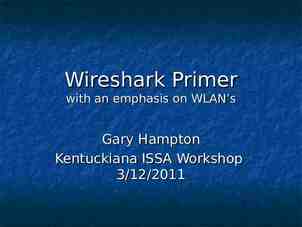Crime Scene Investigation and Evidence Collection SFS1.
31 Slides4.03 MB
Crime Scene Investigation and Evidence Collection SFS1. Obtain, evaluate, and communicate information to properly conduct a forensic investigation of a crime scene. a. Construct an explanation of how scientific forensic techniques used in collecting and submitting evidence for admissibility in court have evolved over time. Emphasis is on Locard’s Exchange Principle, Frye standard, Daubert ruling) b. Plan and carry out investigations using the scientific protocols for analyzing a crime scene (e.g., search, isolate, collect, and record). c. Construct an argument from evidence explaining the relevance of possible evidence at the site of an investigation. d. Develop models to analyze and communicate information obtained from the crime scene. Properly document and sketch a crime scene. 1
LOCARD ’ S EXCHANGE PRINCIPLE Dr. Edmond Locard, director of the world’s first forensic lab (1910, Lyon, France), established the idea of the exchange principle; namely that: 1. When a person comes in contact with an object or another person, a cross-transfer of physical material can occur. 2. Study of the material can determine the nature and duration of the transfer. 2
When you pet a dog and get dog hair on your shirt, that is primary transfer. Transf er When you then go and hug someone and some dog hair goes from you to your friend’s shirt, that is secondary transfer. If your friend then hugged someone and transferred the dog hair, what would that be? 3
TYPES OF EVIDENCE Statements of a witness in court would be direct evidence. Indirect or circumstantial evidence, such as a fingerprint (physical evidence) or blood or hairs (biological evidence), would imply something, and is called trace evidence. 4
INDIVIDUAL VS CLASS EVIDENCE Individual Evidence: material that can be related to a single source; individualization always involves comparison Class Evidence: material that can be associated only with a group of items that share properties or characteristics 5
THE CRIME SCENE INVESTIGATION TEAM Who is at the crime scene? Police Possibly a district attorney Crime scene investigators Medical examiner and/or coroner Detectives Specialists 6
THE CRIME SCENE The first officer to arrive at the scene is responsible for securing the crime scene. First priority should be given to obtaining medical assistance for individuals in need of it and to arresting the perpetrator. Detain and separate witnesses As soon as it is possible, remove all unauthorized personnel from the scene. 7
SURVEYING THE CRIME SCENE The Walkthrough—initial survey of the crime scene 1. Perpetrator’s point of entry and exit are located. 2. Indirect path is taken to the center of the crime scene. 3. Obvious items of evidence are located and documented. 4. The conditions of the scene are observed and recorded. Special attention is paid to items or conditions that suggest timing of the incident or do not appear to belong. Investigators should never do anything that might alter the crime scene including smoking, eating, drinking, or 8 littering. FORENSIC SCIENCE: An Introduction by Richard Saferstein
SEARCHING THE CRIME SCENE Line/Strip Search Pattern One or two investigators start at the boundary of the crime scene and search in straight lines across to the other side of the crime scene. Grid Search Pattern Two or more investigators form a grid by searching in line patterns that overlap and are perpendicular to each other. Spiral Search Pattern One investigators searches in a spiral path from the center of the crime scene to the boundary (outward) or from the boundary of the crime scene to the center (inward). Quadrant/Zone Search Pattern The crime scene is divided into smaller sections (zones). One 9 or more investigators are assigned to search each zone. FORENSIC SCIENCE: An Introduction by Richard Saferstein
Figure 2–7 Several typical examples of crime-scene search patterns. The pattern selected normally depends on the size and locale of the scene and the number of collectors participating in the search. 10
CRIME SCENE NOTES Note taking begins when the investigator is contacted and requested to report to the crime scene. The crime scene notes should begin with: The identity of person who contacted the investigator Time of contact and arrival at the crime scene Preliminary case information Personnel present on arrival and those being contacted FORENSIC SCIENCE: An Introduction by Richard Saferstein 12
PHOTOGRAPHY The most important prerequisite for photographing a crime scene is for it to be in an unaltered condition. Unless there are injured parties involved, objects must not be moved until they have been photographed from all necessary angles. 13
PHOTOGRAPHY The four minimum photographs required at a crime scene are: an overview photograph, a medium range photograph, a close-up photograph, a close-up photograph with a scale. FORENSIC SCIENCE: An Introduction by Richard Saferstein 14
VIDEOTAPING CRIME SCENES As with still crime scene photography, the crime scene video must include overview, medium-range, and close-up images. A narrated crime scene video combines photography and notes. Some video cameras can produce still photographs, but the quality is often poor. Therefore, still photographs from a digital camera are still required. FORENSIC SCIENCE: An Introduction by Richard Saferstein 15
SKETCHING THE Crime scene sketches: CRIME SCENE Clearly show the layout of a crime scene Show a proper scale of the objects Clarify objects and features already described in notes or shown in photographs Show measurements over long distances and topography of outdoor scenes Depict possible paths of entry, exit, and movement through the scene FORENSIC SCIENCE: An Introduction by Richard Saferstein 16
THE ROUGH CRIME SCENE SKETCH A rough sketch is created at the crime scene and contains an accurate depiction of the dimensions of the scene and shows the location of all pertinent objects and features. All rough sketches include: Title block with information on the case, crime scene, and person creating the sketch Legend with identity and dimensions of objects in the sketch Compass showing the North direction Body containing the sketch itself Points of reference for objects can be shown by the distance measurements from two fixed points. FORENSIC SCIENCE: An Introduction by Richard Saferstein Courtesy Sirchie Finger Print Laboratories, Inc., Youngsville, NC: www.sirchie.com
THE FINISHED CRIME SCENE SKETCH The finished sketch is created from the information in rough sketch, but it is drawn to scale with care and concern for appearance. The current standard method utilizes Computer-Aided Drafting (CAD) programs to create the finished sketch. CAD programs also allow for the creation of threedimensional finished sketches. FORENSIC SCIENCE: An Introduction by Richard Saferstein 18Courtesy Sirchie Finger Print Laboratories, Inc., Youngsville, NC: www.sirchie.com
PACKAGING Each different item or similar items collected at different locations must be placed in separate containers. 19
PACKAGING Biological evidence is placed in non-airtight containers and allowed to dry Liquid or volatile evidence are placed in airtight containers Small amounts of trace evidence can also be conveniently packaged in a carefully folded paper, using what is known as a bindle or druggist fold. 20
CHAIN OF CUSTODY Chain of Custody—A list of all persons who came into possession of an item of evidence. Adherence to standard procedures in recording the location of evidence, marking it for identification, and properly completing evidence submission forms for laboratory analysis is critical to chain of custody. 21
ANALYZE THE EVIDENCE The facts of the case are determined when the forensic lab processes all the collected evidence. The lab then sends the results to the lead detective who aims to see how it all fits into the crime scenario. 22
ANALYZE THE EVIDENCE The lab results can: Show how reliable are any witness accounts. Establish the identity of suspects or victims. Show suspects to be innocent or link them with a scene or victim. 23
Figure 1–10 An envelope containing anthrax spores along with an anonymous letter was sent to the office of Senator Tom Daschle shortly after the terrorist attacks of September 11, 2001. A variety of forensic skills were used to examine the envelope and letter. Also, bar codes placed on the front and back of the envelope by mail-sorting machines contain address information and information about where the envelope was first processed. Courtesy Getty Images, Inc.—Liaison 24
CRIME SCENE RECONSTRUCTION Crime scene reconstruction involves: – forming a hypothesis of the sequence of events from before the crime was committed through its commission. 25
A laser beam is used to determine the search area for the position of a shooter who has fired a bullet through a window and wounded a victim. The bullet path is determined by lining up the victim’s bullet wound with the bullet hole present in the glass pane. 26
STAGED CRIME SCENES When the lab results do not match up with the testimony of witnesses, it can mean the crime was staged; common examples include: Staging a fire—to cover bankruptcy. Staging a suicide—to cover a murder. Staging a burglary—to collect insurance money. 27
THE CRIME LAB Over 400 public crime laboratories in the US operate at various levels of government— federal, state, county, and municipal. 28
SKILLS OF A FORENSIC SCIENTIST A forensic scientist must be skilled in applying the principles and techniques of science to the analysis of the many types of evidence that may be recovered during a criminal investigation. A forensic scientist may also provide expert court testimony. An expert witness is an individual whom the court determines possesses knowledge relevant to the trial that is not expected of the average person. The expert can express an opinion as to FORENSIC SCIENCE: An Introduction by Richard Saferstein 29
THE FRYE STANDARD The Frye v. United States decision set guidelines for determining the admissibility of scientific evidence into the courtroom. To meet the Frye standard, the evidence in question must be “generally accepted” by the scientific community. FORENSIC SCIENCE: An Introduction by Richard Saferstein 30
THE DAUBERT CRITERIA However, in the 1993 case of Daubert v. Merrell Dow Pharmaceutical, Inc., the U.S. Supreme Court asserted that the Frye standard is not an absolute prerequisite to the admissibility of scientific evidence. Trial judges were said to be ultimately responsible as “gatekeepers” for the admissibility and validity of scientific evidence presented in their courts, as well as all expert testimony. FORENSIC SCIENCE: An Introduction by Richard Saferstein 31




































